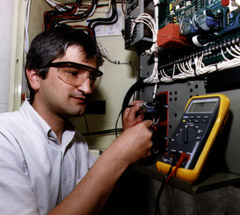|
Martin, 33, specializes in the protection of the power distribution
system. That means making sure it does not carry too much of a
load, and that it can safely shut down quickly if there is a fault
on the line.
"I'm regarded
- even by the engineers - as one of the province's gurus with
respect to distribution protection," he says.
Martin works
on the part of the power system that delivers electricity along
feeder lines running from substations to the transformers outside
customers' buildings.
Protecting
the power system can include deciding when it's time to build
a new substation or working with the operators of industrial facilities
(there are several sawmills in Martin's district) to ensure that
their equipment will function without affecting residential customers.
"These larger
services can impact the system in a negative way - if they're
starting a big motor, for instance. You don't want to sit in your
kitchen watching your lights get dimmer and dimmer while the sawmill
next door is feeding logs through," he explains. Martin also has
to strike a delicate balance between shutting the system down
quickly in the event of a fault (an overload, for instance, or
a tree crashing through a line), and being certain it won't shut
down unnecessarily.
"We have to
ensure that device settings are protecting the feeder," Martin
says. "We do an analysis of the feeder to determine the fault
level. We look at that level and coordinate the devices on the
lines. You don't want them all to trip, just the ones closest
to the fault. So instead of taking 3,000 customers out, you isolate
it so you only take out 35."
|


